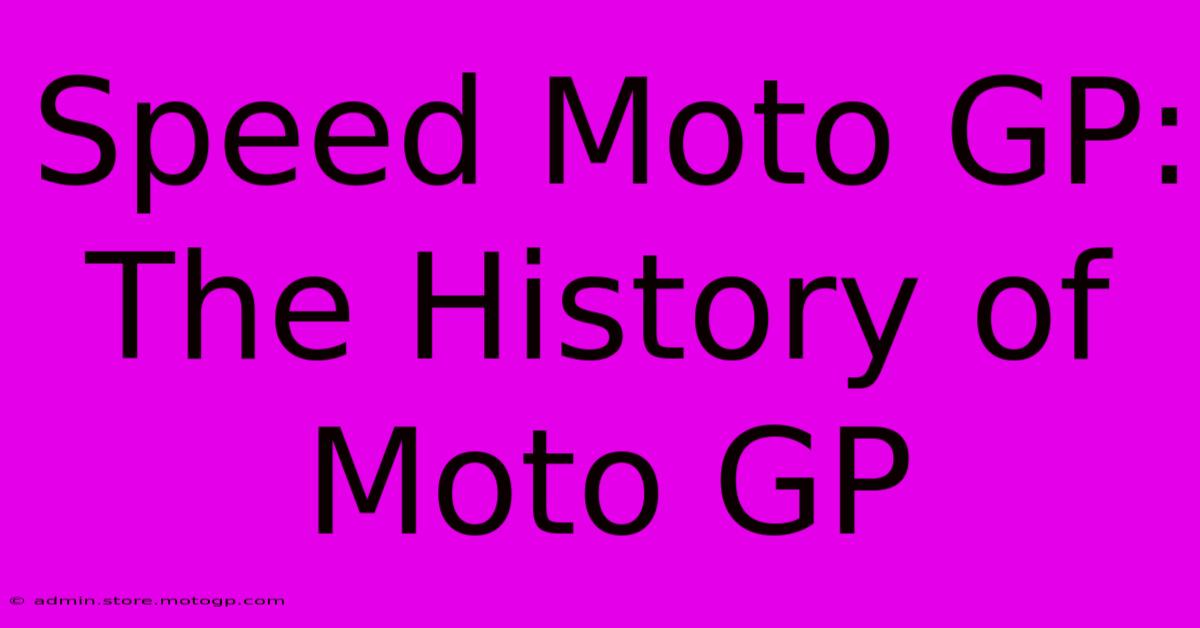Speed Moto GP: The History Of Moto GP

Table of Contents
Speed Moto GP: The History of Moto GP
Motorcycle racing, a thrilling spectacle of speed, skill, and adrenaline, has captivated audiences for over a century. At the pinnacle of this exhilarating sport sits MotoGP, the premier class of motorcycle road racing. But how did this global phenomenon evolve? Let's delve into the rich history of MotoGP, tracing its origins and evolution to the electrifying championship we know today.
The Genesis of Grand Prix Racing: Early Days and the Formation of the FIM
The roots of MotoGP lie deep within the early days of motorcycle racing. Independent races and competitions sprang up across Europe in the early 20th century, showcasing the burgeoning technology and daring spirit of riders and manufacturers alike. The Fédération Internationale de Motocyclisme (FIM), the governing body of international motorcycle sport, was founded in 1904, laying the groundwork for the standardization and regulation of motorcycle racing, eventually leading to the formalization of Grand Prix racing.
The Pre-MotoGP Era: 500cc reigns supreme
For decades, the 500cc class dominated the Grand Prix world, representing the ultimate test of power and skill. Legendary names like Giacomo Agostini, Mike Hailwood, and Barry Sheene etched their names into the annals of racing history, achieving remarkable feats of speed and endurance on powerful machines. These riders were not just racers; they were icons, capturing the imagination of millions worldwide and shaping the future of MotoGP. The competition was fierce, with technological advancements constantly pushing the boundaries of speed and performance.
The Birth of MotoGP: A New Era Begins
The year 2002 marked a significant turning point: the 500cc two-stroke era gave way to the MotoGP class, featuring 990cc four-stroke engines. This transition brought about a significant shift in the dynamics of the sport, requiring riders and manufacturers to adapt to the new technological landscape. The change signified a move towards more sophisticated, technologically advanced motorcycles, further enhancing the excitement and competitive intensity of the races.
The Rise of the Four-Stroke: Technological Advancements and New Challenges
The introduction of four-stroke engines presented both challenges and opportunities. The increased torque and engine characteristics demanded a different riding style and engineering approach. Manufacturers like Honda, Yamaha, Ducati, and Suzuki invested heavily in research and development, leading to an arms race of innovation that dramatically improved the overall performance and capabilities of MotoGP bikes.
MotoGP Today: A Global Spectacle
Today, MotoGP is a global phenomenon. The championship attracts millions of fans worldwide, with races held on iconic tracks across the globe. The competition is fiercer than ever, with top riders battling for supremacy on technologically advanced machines. The sport showcases the pinnacle of motorcycle technology, athleticism, and strategic team management.
Key Players Shaping Modern MotoGP
Several key players shape the modern MotoGP landscape:
- Manufacturers: Honda, Yamaha, Ducati, Suzuki, KTM, and Aprilia are constant competitors, pushing the boundaries of motorcycle technology and design.
- Riders: The current MotoGP grid is packed with talented and renowned riders, constantly pushing the limits of their machines and racing skill.
- Teams: Dedicated teams provide expert mechanical support, strategic guidance, and unwavering commitment to their riders.
- The FIM: The FIM continues to oversee and regulate the sport, ensuring fair competition and safety standards.
The Future of MotoGP: Innovation and Evolution
The future of MotoGP is certain to be just as exciting as its past. Technological advancements, such as the incorporation of electronics and improved aerodynamics, continue to drive performance improvements and redefine the competitive landscape. Sustainability and environmental concerns are also increasingly influencing the direction of the sport, prompting manufacturers and the FIM to explore alternative fuel sources and greener technologies.
In conclusion, MotoGP's history is a thrilling tapestry woven with innovation, rivalry, and the pursuit of ultimate speed. From its humble beginnings in early motorcycle racing to its current status as a global spectacle, MotoGP continues to captivate audiences and inspire generations of riders and engineers. The future promises even more advancements, ensuring the sport's ongoing evolution and enduring appeal.

Thank you for visiting our website wich cover about Speed Moto GP: The History Of Moto GP. We hope the information provided has been useful to you. Feel free to contact us if you have any questions or need further assistance. See you next time and dont miss to bookmark.
Featured Posts
-
Is Moto Gp Aerodynamics Going Too Far
Feb 20, 2025
-
Austin Gp Concert A Sensory Overload
Feb 20, 2025
-
Cota Grandstands Experience The Heart Pounding Action
Feb 20, 2025
-
Racing Style Essentials Circuit Of The Americas Store Finds
Feb 20, 2025
-
Unlock The Sounds Of Speed F1 Austin Music Guide
Feb 20, 2025
